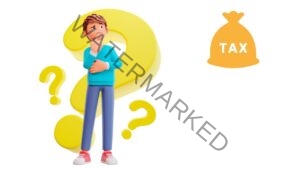Introduction
This post is about deposits into the business bank statements and not personal bank statements. Many businesses have been penalized because they cannot explain the source of deposits into their bank accounts.
(Post continues after photo)

(Photo by Waka)
The post lists some of the sources of deposits into the bank account and what the business should do so that the deposits are not treated as business deposits.
Production of bank statements
The first step in establishing a business’s tax liability is to determine the sales in a year of income. It is important to remember that tax reporting is done for each year of income. Hence, tax audits are done for each year of income.
Bank statements for the business’s bank account or accounts are some of the records that the business is required to maintain and produce for examination to an authorized tax officer under the tax law.
Under the tax laws, it is an offence to refuse to produce bank statements. The business must provide bank statements when asked to do so.
Note that the bank statement is required for income tax, value-added tax, domestic excise tax, customs especially because of post-clearance audits and many other taxes.
Let us examine a bank statement
If you look at your bank statement, there are various columns. One of the columns is the deposits column. This column is a record of the money that was deposited into the bank account.
Tax officers want to know where your deposits came from. In normal circumstances, the deposits should be from sales …. Sales proceeds – from credit sales and cash sales for the whole year of income.
But is that the case?
No … there are deposits from elsewhere. It is only in very special circumstances that a bank statement will have deposits from sales proceeds only.
What are some of the sources of the other deposits?
There are many sources of deposits into a bank account. However, this list will only examine a few.
Payments previous years debtors
Business debtors from the previous year or years may decide to make payment during the year of income under examination. These payments will be reflected as deposits in the bank statements.
Formal loans
These are loans from banks, microfinance institutions, financial institutions or other lenders. The loans may be for investments. For example, the loans may be for the purchase of machines or construction of buildings. The loans can also be for day to day operations of the business.
Loans from family
Sometimes businesses get loans from close family members and relatives such as parents, sisters, brothers, sons etc. The loans normally do not have interests and may also not have the periods within which to be paid.
Loans from informal lenders
In every market, there are informal lenders such as shylocks. These loans will have time frames within which they should be paid. The loans normally have an interest. The loans are often deposited into the bank statements.
Loans from other businesses
Occasionally, some companies rely on business-to-business loans. The loans are often soft loans whose repayment period may be within a short time or it may not be specified. The loans are deposited into the bank accounts.
Capital injection by shareholders or directors
When businesses do not have adequate resources, they may ask current shareholders and/or directors to inject more capital into the business. This may be either equity capital or loans.
Re-banked cheques
Many times when cheques from customers or clients bounce, the businesses are asked to re-bank the cheques. The re-banked cheques will appear as deposits for the second time and as many other times as they are re-banked.
Inter-bank cash transfers
Some businesses hold bank accounts in different banks. Sometimes, there are inter-bank money transfers. The money transferred appeared as a deposit in the sources bank account and will again reflect as a deposit in the destination bank account.
Inter-account cash transfers
Businesses sometimes hold several accounts in the same bank. Occasionally, there are funds movements across the accounts for whatever reason. Every time the money is moved, it is reflected as a new deposit into the destination account.
Bank errors
Like every organization, banks make mistakes. Sometimes, money is deposited into the business account and the owner does not know where the money came from. The equivalent of the money is then removed.
Tax refunds
Sometimes the tax authorities refund tax to businesses. Such refunds may be VAT refunds, tax paid in error, overpaid taxes etc. The tax refunds will be deposited into the business bank accounts.
Insurance claims
Business makes insurance claim when there is a need to. When the claims are paid, the money is deposited into the business account.
Court awards
Businesses seek court redress when aggrieved. The court awards in case they are monetary will be deposited into the business bank accounts.
Investments returns
Businesses also invest in other businesses for profits. When other businesses make profits and distribute them, the business will receive investment returns. The returns are in the form of dividends. The dividends will be deposited into the business account.
Sale of business assets
Occasionally, businesses sell assets either to raise funds or because they no longer require the assets. The proceeds from the sale of the assets are deposited into the bank accounts.
Donations
Some very generous benefactors of the business including the government may decide to donate some money to the business. The donations are deposited into the bank accounts.
What should business do about the deposits from other sources?
There are several proactive steps that a business can take so that the deposits from the other sources are not treated as sales deposits. The following are some of the steps.
a) Note the source of each deposit – create a column and indicate where each deposit came from.
b) In the case of capital injection by shareholders and directors – maintain updated shareholder’s director’s current account.
c) In case of loans, have documentary evidence of the sources of the deposits. The same treatment for formal loans is applied for informal loans.
For example, there is a need for at least 5 letters to prove there was communication and the loan is an official loan to the business.
- Minutes for the Board of directors meeting where it is decided that the business requires money and where to borrow from.
- Letter of request to the person or persons from whom the business money was borrowed.
- Letter from the lender indicating their willingness to lend the money to the business and the terms of the loan:- the period of the loan, interest rate if any, currency of the loan, how the money will be paid etc.
- Letter from the business agreeing to the terms and conditions of the loan.
- Letter from the lender informing the business that the money has been dispatched.
d) Frequent bank reconciliations periodically either weekly, monthly or after some time.
By undertaking the above steps, the business will not have problems explaining the source of extra deposits,
Feel free to send us questions or topics on tax and investments in Kenya that you would wish to be covered in this Website.
Disclaimer
This post is for general overview and guidance and does not in any way amount to professional advice. Hence, www.taxkenya.com, its owner or associates do not take any responsibility for results of any action taken on the basis of the information in this post or for any errors or omissions. Kenyan taxpayers must always rely on the most current information from KRA. Tax industry in Kenya is very dynamic.
©Wakaguyu Wa Kiburi
[about-me id=”1″]
Email: taxkenya@gmail.com
Twitter: @taxkenya
Facebook: fb.me/taxkenya
Youtube: youtube/taxkenya.com shows



